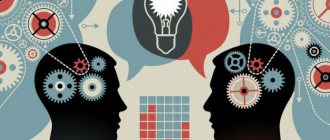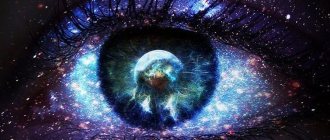Do you know that by understanding your type of perception (who you are: visual, auditory, kinesthetic, digital) you can increase the quality and speed of your learning and be able to convey your thoughts to a person with high accuracy? How to determine the types of information perception and how to use this knowledge in communication and learning will be discussed in detail in this article.
A ten-year-old child who was considered completely incapable of learning was brought to a wise teacher. Parents complained that no matter how hard they tried, they could not teach their son the simplest arithmetic. No matter how hard they tried to fold sticks, apples, or point with their fingers, nothing came out. He couldn't learn to add and subtract. The teacher talked to the boy for a few minutes. Then he asked his parents to sit aside while he taught their boy to count. Then the teacher asked the boy to stand up and jump over the pebbles. At first the boy simply jumped over the stones. Then the teacher said: “Look, do one jump, then a second, and then jump twice more. How many times did you jump in total?” And suddenly the boy answered - 4. Then the boy jumped and counted even more, in one day he mastered arithmetic, which ordinary children master in six months. The parents sat with their mouths open.
Why was this possible? The teacher was wise. He understood that this boy needed to be taught a lesson in such a way that he would be able to perceive it . He didn’t just hear, but perceived it in the way that was most understandable to him.
Today we will talk about what types of perception there are, and how understanding the types of perception of information helps in relationships and learning. And also about how to determine your type of perception.
In the simplest approximation, there are four types of information perception: visual, auditory, kinaesthetic, digital.
Content
- Physiological mechanism of perception
- Properties of perception
- Principles of perception
- Perception factors
- Effects of perception
- Classification of types of perception
- Perceptual disturbances Illusions of perception
- Hallucinations Eidetism as a type of hallucination
If we compare the definitions of two mental processes, i.e. perceptions and sensations, then you can notice some features. For example, perception is a more complex process. If sensations reflect individual properties of objects, then perception is a holistic reflection. Thus, the result of perception is a holistic perceptual image of an object, and not a separate property of it.
Physiological mechanism of perception
The physiological basis of perception is the processes taking place in the sense organs, nerve fibers and the central nervous system. Under the influence of stimuli at the endings of the nerves present in the sensory organs, nervous excitation arises, which is transmitted along pathways to the nerve centers, and, ultimately, to the cerebral cortex. Here it enters the sensory zones of the cortex, which represent, as it were, the central projection of the nerve endings present in the sense organs. Depending on which organ the sensory zone is connected to, certain sensory information is generated.
Since perception is closely related to sensation, it can be assumed that it, like sensation, is a reflexive process. Ivan Petrovich Pavlov showed that perception is based on conditioned reflexes, i.e. temporary nerve connections formed in the cerebral cortex when receptors are exposed to objects or phenomena.
Temporary nerve connections that ensure the process of perception can be of two types: 1. Formed within the same analyzer; 2. Interanalyzer.
The first type occurs when the body is exposed to a complex stimulus of one modality (for example, a melody). The second type of neural connections formed under the influence of a complex stimulus are connections within different analyzers, the emergence of which Sechenov explained by the existence of associations. These associations in humans are necessarily accompanied by an auditory image of the word, thanks to which the perception acquires a holistic character.
[edit] Behavioral indicators
| Visual | Audial | Kinesthetic |
| Organized | Talking to himself | Responds to physical reward |
| Neat and disciplined | Easily distracted | Stands close, touches people |
| Observant | Moves lips, pronounces words when reading | Physically oriented |
| Quiet (not noisy) | Easily repeats what he hears | Abundance of movements |
| Focused on appearance | More prefers counting and writing | Rich physical reactions |
| More cautious | Easily masters languages | Early physical development |
Properties of perception
1. Objectivity of perception
This is the ability to reflect objects and phenomena of the real world not in the form of a set of unrelated sensations, but in the form of individual objects. Objectivity is not an innate property of perception. The emergence and improvement of this property occurs in the process of ontogenesis, starting from the first year of a child’s life. According to Ivan Mikhailovich Sechenov, objectivity is formed on the basis of movements that ensure the child’s contact with the object (hand movements; eye movements that trace the contour of the object, etc.). Without the participation of movement, images of perception would not have the quality of objectivity.
2. Integrity of perception
Perception gives a holistic image of an object. It is formed on the basis of generalization of information received in the form of various sensations about the individual properties and qualities of an object. The components of sensation are so strongly interconnected that a single complex image of an object arises even when only individual properties or individual parts of the object directly affect a person. This image arises conditionally as a result of the connection between various sensations.
The integrity of perception is expressed in the fact that even with incomplete reflection of individual properties of the perceived object, the received information is mentally completed into a holistic image of a specific object.
3. Structurality of perception
The structure of perception is not just a collection of sensations. It reflects the relationship between various properties and parts, i.e. structure of the subject. Perception brings to our consciousness the structure of an object or phenomenon that we encounter in the real world. We can say that the structure of perception is a reflection of the specific relationship of the elements of the whole. For example, notes enter consciousness, and we recognize the melody, we recognize the triangle in the figure, because we know the aspect ratio of a given figure, or a certain letter remains the same letter despite a different writing style.
Structurality is associated with another property of perception - integrity.
4. Constancy of perception
Constancy is the relative constancy of the image of an object when the conditions of its perception change (for example, a car seems large to us at any distance from it). Constancy is observed to the greatest extent in the visual perception of color, size and shape of objects. Thanks to constancy, which manifests itself in the ability of the perceptual system (a perception system that consists of a set of certain analyzers) to compensate for changes in the conditions of perception, we perceive the objects around us as relatively constant.
A person repeatedly perceives a certain object, and this object is perceived under completely different conditions. This allows the system to maintain relative constancy of the properties of objects and phenomena. Without constancy of perception, people would not be able to navigate the world around them.
5. Apperception
Apperception is the dependence of perception on past experience and personality traits of the perceiver. A person’s knowledge and previous experience play a huge role in apperception. In the process of perception, in order to classify what you perceive, you will put forward and test hypotheses about whether an object belongs to a particular category of objects.
Thus, during perception, past experience is activated. Therefore, one object can be perceived differently by different people. The content of perception is determined by the task, motives of activity, interests. An essential place in apperception is occupied by attitudes and emotions, which can easily change the content of perception.
6. Meaningfulness of perception
Meaningfulness of perception is the property of human perception to endow the perceived object with a certain meaning. Perception is not determined simply by a set of stimuli, but is a constant search for the best interpretation of the data received.
We perceive objects that have a certain meaning. Regardless of the constantly changing content, we learn the same subject. Human perception, being a kind of awareness of objects and phenomena, includes the act of understanding and comprehension.
7. Activity (selectivity) of perception
Selectivity of perception lies in the fact that at any given time we perceive only one object or a specific group of objects, while other objects in the surrounding world are the background of our perception (not reflected in consciousness).
For example, while in a lecture hall, you listen to a lecture without noticing that someone behind you is discussing plans for the evening. Your perception is directed towards the lecture until you are asked about your plans. In this case, you will already be communicating and not listening to a lecture, i.e. perception will be directed towards the interlocutors.
Visual, auditory, kinesthetic, digital in the learning process
If you study a lot, go to courses, trainings, read, then understanding your own type of perception will help you organize your own learning process with maximum benefit.
Visuals
The basis of their learning is visual information. For visual people, hearing and vision form a single whole, therefore, if such a person only heard the material (but did not see), then with a high degree of probability the information will be quickly forgotten. Visual learners instantly absorb all visual information, so it is most beneficial to use all methods and techniques for visually presenting the material:
- mind maps
- scheme
- graphs
- illustrations
- photos
- demonstration models
- experiments, experiments
Visual learners learn best through visual examples, where they see the material they are learning in real time. Primary memory is visual. They remember well the location of objects, paths, roads, and are well oriented in space. Some noise is not critical for a visual learner; he can concentrate in an environment of some noise and successfully study the material.
Read the article - What are mind maps. How to make a mind map
Visual learners perceive text information well and are able to quickly learn speed reading.
Audial
Uses the auditory perception channel as a trigger. Inner speech is moderately developed. They perceive lectures, music, conversations, and dialogues well. They clearly and effectively maintain the line of conversation and conversation; often it is during the conversation that they grasp the meaning of the material being studied. Silence is necessary when concentrating. If you are an auditory learner, then be sure to listen to lecture material and audio courses. Learn together with others, discussing the topic being studied, thinking out loud about the problem.
Kinesthetic
Receives information through actions and movements. He remembers any actions and practical exercises well. He perceives all information best through practical exercises and experiments, where he tests the information received with his own hands in practice. Information of a practical nature is especially well perceived: what moves and how, where to click.
It is important for kinaesthetic learners to feel, touch, smell, taste and fully experience the subject being studied. People of this type are very active, love and enjoy working. And they don’t like inaction. It is for kinesthetic learners that the saying “Movement is life” has a special meaning. It is very difficult for kinaesthetic people to maintain focus, they are easily distracted, it is difficult for them to sit still for a long time, or to do routine work.
Digital
They are well trained in all sciences that have strict logic and consistency: mathematics, physics, mechanics, technology. Such people often work in areas where there is a lot of research, mathematical and static processing, and programming. The main thing for digital is to understand the logic and connections in the material, to organize what is being studied into a system with clear cause-and-effect relationships. Therefore, during your studies, try to build the logic of the entire topic being studied. For this you can use:
- scheme
- mind maps
- compressed plans
- Personally compiled thesauri
Principles of perception
A group of psychologists, together with Max Wertheimer, a German psychologist and founder of Gestalt psychology, formulated the laws of perception, which became the theoretical basis of Gestalt psychology.
1. The principle of proximity Elements that are close to each other in space and time and that seem to us to be united in groups, we perceive together.
2. Principle of Continuity There is a tendency to follow a direction that allows observed elements to be linked into a continuous sequence or a specific orientation. In the figure we see not just individual dots, but two intersecting lines.
3. Principle of similarity Similar elements are perceived by us together, forming closed groups. Because of the color, we perceive the points in the figure as rows rather than columns.
4. Closure principle There is a tendency to complete unfinished items and fill empty spaces.
5. The principle of simplicity (the law of content, the principle of good form, the law of pregnancy) We perceive and interpret composite or complex objects as the simplest form or a combination of the simplest forms. In the figure we see three different simple figures, and not one complex one.
Pregnant gestalt means that in any conditions we strive to see the figures as complete as possible.
6. Figure-ground
We strive to organize our perception in such a way as to see the object (figure) and the background against which it appears. The object is brighter, more significant, and noticeable.
Smell and taste
Gustatory and olfactory perceptions are much closer to sensations, that is, to elementary sensory processes, than vision and hearing, which have undergone great evolutionary changes in humans. In addition, smell and taste are so closely interconnected that we often confuse them, or rather, we endow taste with the characteristics of odors. For example, when we talk about taste diversity. There is no variety; a person is able to sense only five tastes:
- sweet,
- salty,
- sour,
- bitter,
- spicy.
By taste variety, we most often mean smells. There really are a huge number of them, because each item smells differently.
The sense of smell is always objective, that is, we perceive smells through their connection with objects: lemon smells like lemon, raspberries smell like raspberries, and asphalt heated by the sun smells like lemon. But a completely unfamiliar smell, which we don’t associate with anything, is impossible to describe. Try to explain to a person who has never been to the sea what it smells like?
Perception factors
Our perception depends on external and internal factors.
a) External factors: - intensity of the stimulus; — size of the stimulus; — stimulus contrast; - movement of the stimulus; - recognition of the stimulus.
b) Internal factors: - human attitude; — needs; - experience; — personal characteristics (self-esteem, left- or right-handedness, optimism-pessimism, etc.); - effects of perception.
What is information?
The concept of “information” has an abstract meaning and its definition largely depends on the context. Translated from Latin, this word means “clarification”, “presentation”, “familiarization”. Most often, the term “information” refers to new facts that are perceived and understood by a person, and also found useful. In the process of processing this information received for the first time, people gain certain knowledge.
Effects of perception
Let us highlight the main effects (errors) of perception:
The projection effect is the ability of people to attribute their own advantages to a pleasant person, and their shortcomings to an unpleasant person. Those. the effect suggests that other people have the same qualities as the perceiver.
The halo effect is the formation of a specific attitude towards a person through the directed attribution of certain qualities to him; information received about a person is superimposed on the image that was created in advance. Those. the effect is to extend the general opinion to the particulars.
The primacy and recency effect is the tendency of people, when faced with conflicting information about another person, to give more weight to information received first (if a stranger is perceived) or more recent information (if an old acquaintance is perceived).
The effect of physiognomic reduction is the ability of people to draw conclusions about the character and psychological characteristics of a person based on the features of his appearance.
Visual, auditory, kinaesthetic, digital in communication
Visuals
“You meet people by their clothes...” the beginning of this famous proverb applies entirely to visual people. They attach significant importance to a person’s appearance and always pay attention to how a person looks, what clothes he is wearing, what facial features he has, how he moves.
When communicating, they can look into the eyes calmly and for a long time. Visual contact, inverted posture in communication, open postures are extremely important for the visual person. At the same time, they do not like to be close to their interlocutor and keep their distance. The main thing is to see well. Representatives of this type of perception quickly intuitively read the signals of body language and facial expressions, often without noticing it. Sometimes it seems to them that just by looking at them they know the thoughts of another person.
Read the article on nonverbal communication
If you need to impress a visual person, try to pay the most attention to external beauty. The environment, your clothes, gait, facial expressions, and gestures should be as inviting as possible. To prove your words, provide clear examples, graphs, drawings, and be sure to demonstrate your arguments using samples and experiments. Show a picture instead of numbers: visual learners will have difficulty understanding the difference between 1000 and 10,000, but a visual example of the difference will convince them in most cases.
Visual artists themselves are good storytellers. They can imagine amazingly vivid and detailed pictures and talk about them for hours.
Audial
A conversation with an auditory student is often very pleasant. Auditory learners themselves are demanding of their speech; they speak measuredly, with competent changes in intonation. It’s nice to listen to them, it’s nice to talk to the auditory. But auditory learners themselves are very demanding of the speech of their interlocutors; they cannot tolerate errors in speech, incomprehensible and distorted speech. It is absolutely forbidden to shout or raise your voice at auditory learners; this will lead to alienation of the person. Audials are always a pleasure to listen to; they are wonderful storytellers and no less wonderful interlocutors, who can understand at a glance by their intonation and manner of speech.
Kinesthetic
Kinesthetic learners are especially sensitive to spatial surroundings and distances between interlocutors. Close people are allowed into the personal zone, but people they don’t know well are kept at a distance. For kinesthetes, an invasion of their personal zone is offensive, and they begin to experience strong negative emotions. It is best to gain the attention and trust of the kinaesthetic through actions, joint affairs, and common activities.
If you have to remember something, it is better to write it or draw it yourself. Conversations and verbal evidence will make the least impression on a person of this type of perception. And the kinaesthetic always strives to touch and stroke close people. Physical contact is important to him.
Digital
They are insensitive in communication and rarely show emotions in public. Particular attention is paid to the semantic, substantive part of the conversation. Beautiful but empty speech is unpleasant to them. With digital, it is best to get to the point in a conversation, proving the logic and correctness of your words with numbers and facts.
Classification of types of perception
1) Separation by modality: - visual perception; - auditory perception; - tactile perception; - taste perception; - olfactory perception. Combinations of different types of perception are possible.
2) Division by object of perception: - perception of space (includes the perception of size, shape, relative position of objects, their relief, distance and direction); — perception of time (reflection of the duration and sequence of phenomena or events); — perception of movement (reflection of the direction and speed of the spatial existence of objects); — perception of speed; - perception of direction; - perception of a work of art; - perception of the main phenomena of human life.
3) Separation by goal: - intentional (voluntary) perception (we are guided by a previously set goal or task); - unintentional (involuntary) perception (lack of volitional activity and purpose).
4) Division according to the participation of other psychological formations: - emotional perception (perception associated with emotions and feelings); — rational perception (perception subordinate to the thinking process).
Discrete
The ways of perceiving information are directly related to the human senses. The majority of people gain knowledge through sight, hearing, touch, smell and taste. However, types of information perception include those that are primarily associated with thinking. People who perceive the world around them in this way are called discretes. There are quite a few of them, and they are found only among adults, since logic is not sufficiently developed in children. At a young age, the main ways of perceiving discrete information are visual and auditory. And only with age do they begin to actively think about what they saw and heard, while discovering new knowledge for themselves.
Perception disorders
1) Illusions are erroneous perceptions of real objects and phenomena. They can be auditory, visual, olfactory, etc.
Under certain conditions, they occur in most people and can be caused by physical (perception of a spoon in a glass of tea that appears broken), physiological (split images of objects if you press on the side of the eyeball at the moment of perception) and psychological reasons (overestimation of vertical lines compared to horizontal ones) .
Illusions of perception
a) Ebbinghaus illusion
This is an optical illusion of perception regarding size. Two objects of the same size can look different. If one object is placed among smaller objects, it will appear larger than if the same object is placed among larger objects.
b) Ponzo illusion
This is an optical illusion of perception. Mario Ponzo suggested that the human brain determines the size of an object by its background. He drew two identical segments against the background of two converging lines, like a railway track stretching into the distance. As a result, horizontal lines are perceived differently.
c) Aristotle's illusion
This is an illusion of touch. A small object (pencil) is placed between (under) crossed fingers (it’s easier to use the middle and index fingers) so that it touches one finger on the inside and the other finger on the outside. When you move your fingers (and hand) over an object (back and forth), after a while you get the impression that your fingers are touching 2 objects.
d) Zellner illusion
An optical illusion in which parallel lines intersected by a series of short diagonal lines appear to diverge.
e) Müller-Lyer illusion
An optical illusion that occurs when observing segments framed by arrows. The segment framed by the “points” seems shorter than the segment framed by the “tail” arrows.
f) Poggendorff illusion
An optical illusion where the red line is a continuation of the black line, rather than the blue one.
Hallucinations
2) Hallucinations are erroneous perceptions in the absence of an object.
Hallucinations occur with alcohol abuse (delirium delirium), drugs, psychostimulants (LSD, cocaine, etc.), medications (for example, antidepressants), mental illness (schizophrenia, epilepsy), organic brain lesions, cataracts (Charles hallucinations). Bonnet).











